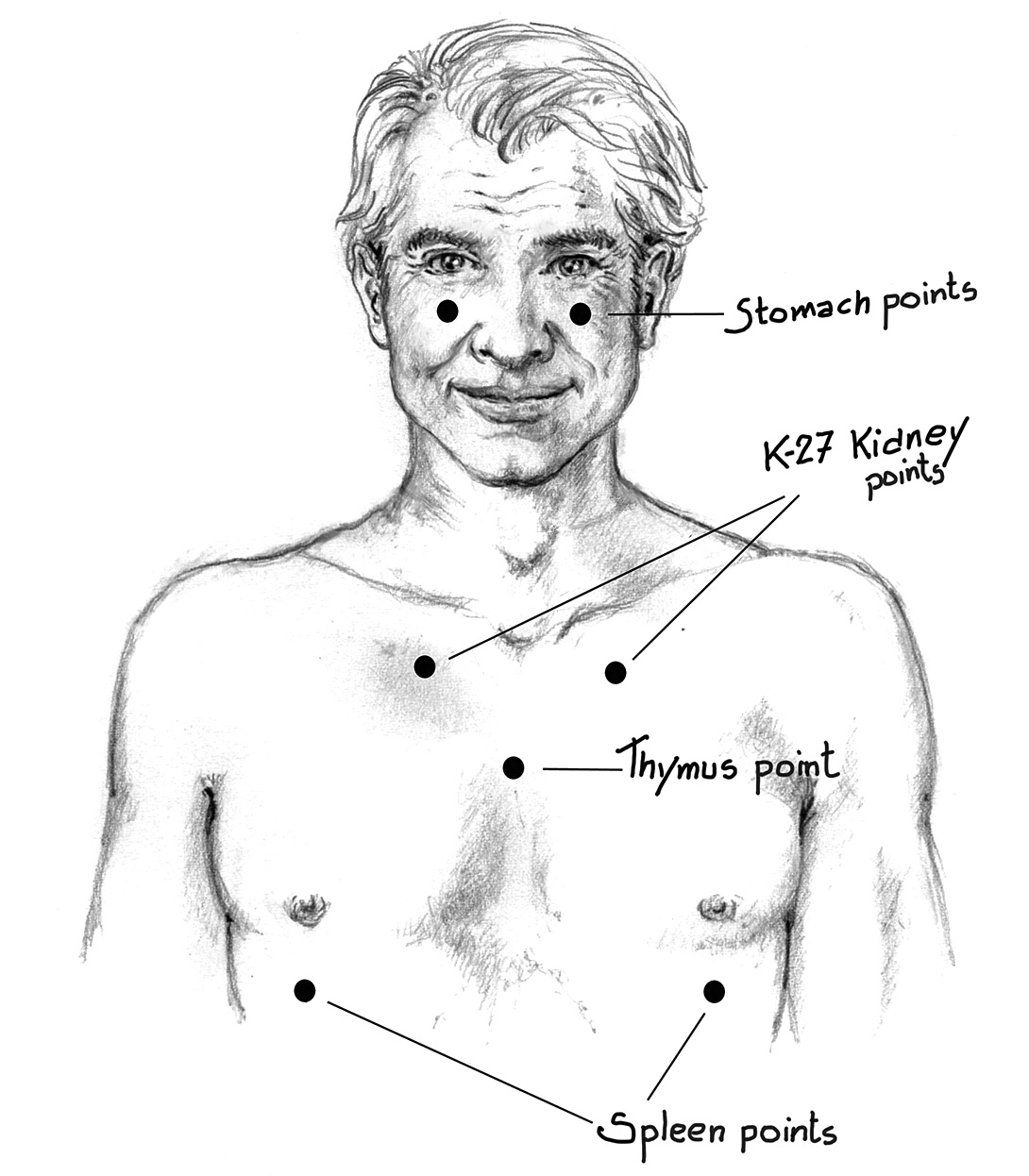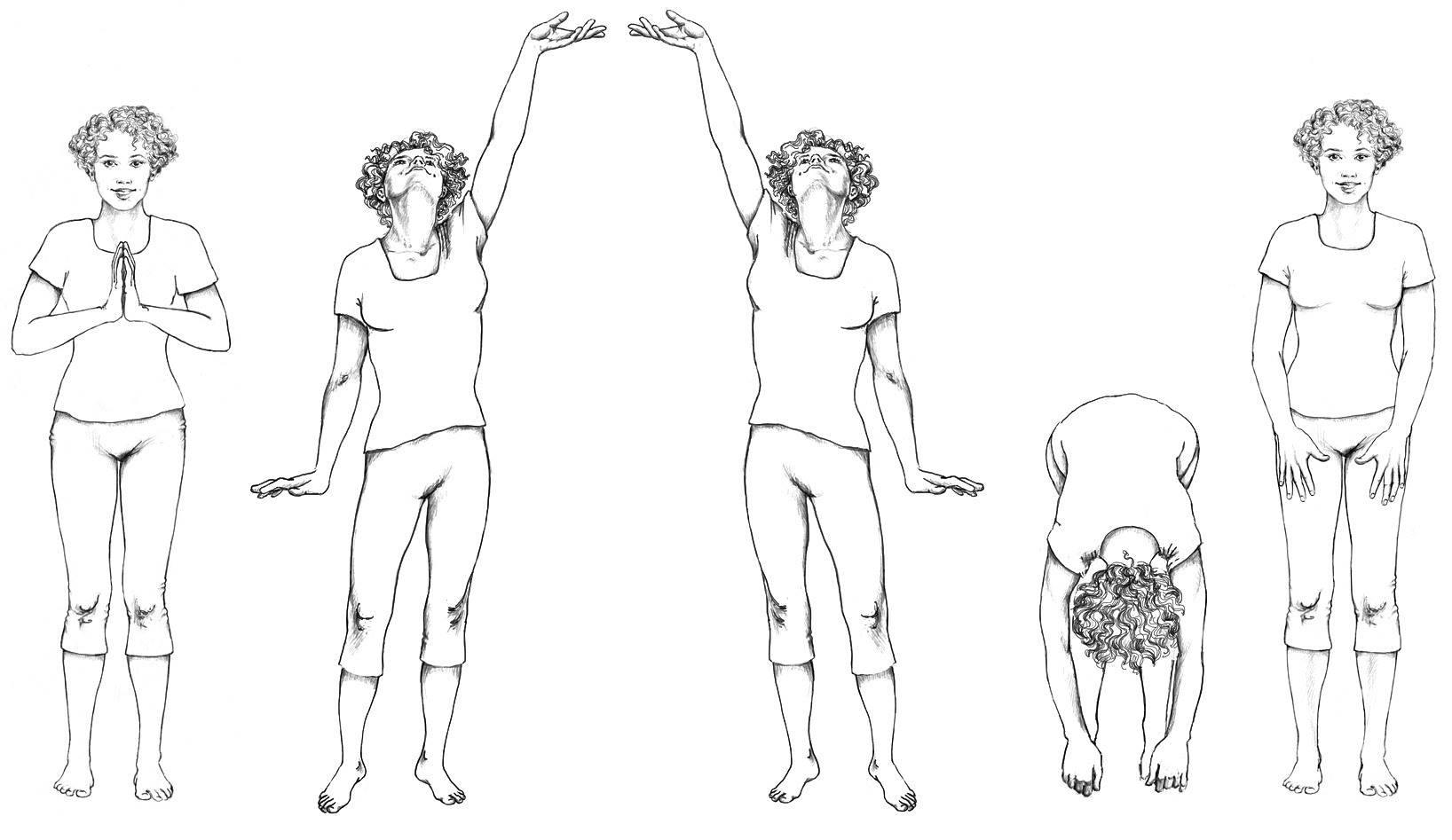3
When Your Energies Collide
A Pact for Setting Things Straight
Use can almost change the stamp of nature.
—WILLIAM SHAKESPEARE, HAMLET
A deep loving partnership is a bond, a collaborative alliance. This bond involves friendship and union that brings out the best in each of you. When it is broken or threatened, you are pulled into your Energetic Stress Style and may fall into fear, rage, or retreat. Sustaining a collaborative alliance, according to David Schnarch, author of Intimacy and Desire, requires you to work together for mutual benefit “even when this is difficult, anxiety-provoking, or painful.”1 More than analyzing what went wrong, it requires a willingness to align with one another in service of the relationship even when every instinct in you wants to strike out or retreat. While a successful marriage may be measured in years, the collaborative alliance ebbs and flows, able to be “made or lost in a split second.”2 Even within a strong relationship, partners aren’t able to stay in a state of collaborative alliance every moment. But the more you can maintain that state, the better your relationship will fare. Positive practices can “almost change the stamp of nature.”
Chapter 2 closed by promising you a Pact that can help you encounter relationship conflict constructively and creatively. This Pact will be able to serve as a means for repairing your collaborative alliance when it has become disrupted. It has four parts, each named for the action it requires:
- Stop
- Tap
- Attune
- Resolve
The acronym STAR will help you remember these four parts. Begin by emblazoning in your mind the first and most elusive step: Stop!
Part 1 of the STAR Pact: Stop
It can happen while you are watching TV, describing a precious event that occurred during your day, sharing a candlelight dinner, or, in the grand tradition of marital conflict, talking about money, sex, or raising the kids. Adrenaline pumps into your bloodstream, your heartbeat accelerates, and your ability to take in and process information diminishes dramatically. You lose your empathy, compassion, creativity, and sense of humor. Your defensiveness is on the rise. Your primal sensory channel takes over, and the sensory modes that usually balance it turn off. John Gottman wryly notes that when such “flooding” occurs, couples may wonder what they ever saw in one another in the first place. You feel overwhelmed by your own reactions and shocked by your partner’s. “You go into ‘systems overload,’ swamped by distress and upset. You may become extremely hostile, defensive, or withdrawn. Once you’re feeling this out of control, constructive discussion is impossible.”3
Yet stopping the discussion, even if you know it has taken a sharp downhill turn, may also seem impossible. Your partner has just assaulted your sacred bond and doesn’t care enough to apologize on the spot and begin to repair it. You’ve been insulted, blamed, or dismissed; fight, flight, or freeze hormones are surging through your arteries; you are caught in your Energetic Stress Style; and an accelerating momentum has taken on its own life. It may feel dreadful, but it is compelling. Stopping at such a moment is usually the hardest part of the Pact, which begins with an agreement to stop at the moment you are aware that defensiveness or anger toward your partner is building:
“If I recognize that a conflict is escalating, I will immediately stop and suggest we do a pre-agreed technique designed to shift our energies. If you make this suggestion, I will immediately interrupt the conversation and join you in the technique you suggest.”
This is so difficult to do because every fiber of your being is engaged in a rapidly escalating conflict. Marriage counselors know that it is critical to prevent people from reenacting the destructive, harmful confrontations that brought the couple into the office.4 Failure to do so not only erodes hope for the relationship and confidence in the therapist, it further establishes the neural pathways of threat and distrust. An effective couples therapist will intervene by providing a structure to the session that does not allow the couple to go into a negative freefall, but instead points them in a constructive direction. The purpose of the Pact is to provide that kind of structure at precisely the times it is most likely for the brain chemistry of threat and distrust to become more deeply established. It is designed to intervene during an interaction that is taking a harmful turn and to put it onto a constructive track. While it requires more determination to implement than if a couples therapist or coach is there in the room telling you to do it, your Pact is much cheaper. It is also on call 24/7.
But for the Pact to work, you need to give it the power you would give to a therapist! If a therapist whom you are paying a substantial fee interrupts your argument and suggests you instead begin to do a relaxation technique, you are likely to obey. The Pact gives you exactly this kind of instruction, and its success rests on an ironclad agreement (made between the two of you during a calm time) that you will implement it to head off a storm at the point when the weather seems to be turning. You won’t be able to create the Pact during the storm, and it will be harder to apply if you have waited until you are in full battle, though it can still be effective even in the midst of full battles—just harder to set into motion.
This first part, Stop, is, in theory, the easiest one to do—you just apply the brakes—yet it is, paradoxically, the hardest phase to initiate. As the intensity of negative emotion rises, you are caught between wishing the altercation would just go away and hearing the nastiest and most provocative words in your repertoire come out of your mouth. It is hard to pause when you would rather righteously drive your point home. Slamming on the brakes despite your biochemistry propelling you forward is, nonetheless, the maneuver you need to establish as your default in order for the Pact to be effective. Unlike communication techniques that are often useless during the height of couples conflict, however, your Pact provides a dependable structure for shifting your agenda from pursuing the conflict to changing the energy (Part 2 of the Pact). Couples can become practiced and capable of switching to an energy technique that breaks the spell that was keeping them in a negative spiral. Changing the energy becomes a shared achievement that is in itself empowering and bonding.
Part 2 of the STAR Pact: Tap
Gottman suggests that the pauses couples take in the face of emotional flooding last at least twenty minutes because that’s the time required for adrenaline and other stress chemicals that were released into the bloodstream to break down. In fact, most people in his research believed that they had completely calmed down after a fight even though their pulse rate was still ten percent above its normal resting rate, leaving them primed for quicker re-arousal. For the break to serve its purpose, (1) it must not be an excuse to avoid the issue, (2) there should be a specific plan for returning to the discussion, (3) it should not be a time to simply rehearse your arguments or relive your sense of betrayal, and (4) the break should be relaxing. This is not, however, easy to accomplish at times of intense interpersonal conflict. To collect yourself when your emotions are raging requires you to swim against a fierce internal tide. Energy techniques quell the tide so the break can be effective.
Introducing simple energy techniques can actually reduce the twenty-minute cooling-off period Gottman prescribes because they help the body process stress more effectively. Of the hundreds of energy medicine techniques we have used in our work, certain ones seem universally powerful and so flexible that they can serve many purposes. Of those, we’ve selected eight that are easy to learn. They have been taught widely, and they are particularly potent for re-centering after coming into an explosive moment in your relationship. When your energies have become disorganized and your mind is in defense mode, you can restabilize body and mind with some or all of the following simple techniques. They begin very simply, by tapping on your body.
The first step of the Pact is to STOP!
The second step is to immediately begin to TAP.
Fight or Flight
You know what the fight-or-flight state looks like physically. People become red in the face (fight) or lose color in their face (flight), they breathe harder, their pupils dilate, and all systems are ready for action. Energetically, the auric field and the chakras become tight like a tensed muscle, mobilizing you into emergency mode. Your energies are not available for an intimate interchange.
Energy Exercises
When you do an energy exercise, such as those described next, the intensity of focused energy in your meridians instantly begins to dissipate. The energy begins to slow and to flow more smoothly. Energies that had left the brain to handle the emergency with a physical response return so you can think more clearly. All systems are calmed.
Just as your Pact includes an agreement to stop the discussion the instant either of you recognizes that one of you has become emotionally hooked, the second agreement is that you will immediately tap on four sets of points on your face and torso. If you can make this your reflexive response, it will immediately begin to balance the energies in your body. You will have these points memorized after just a few run-throughs, so you will be able to do them with little thought. To further balance and stabilize your body’s energies, you can then proceed through some or all of the additional techniques listed here. This will center you energetically, which calms your body and refreshes and refocuses your mind. The centering techniques are:
- The Four Taps
- The Blow-Out/Zip-Up/Hook-Up
- The Crossover Shoulder Pull
- The Crown Pull
- The Stress Release Hold
- The Wayne Cook Posture
- Connecting Heaven and Earth
- The Cross Crawl
It is often a losing battle to try to will yourself to stay centered in the midst of escalating conflict with your partner, but you can will yourself to do physical movements that will calm and align your energies. Your mind will then follow, your coping abilities will return, and it will become possible then to creatively reconnect. Instructions for carrying out each of these eight techniques follow.
The Four Taps
Certain points on your body, when tapped with your fingers, affect your energy field in predictable ways, sending electrochemical impulses to specific regions of your brain and releasing neurotransmitters. By tapping the following sets of points (see figure 3-1), you can activate a series of internal responses that will restore you when you are stressed or simply tired. You can also tap these points at any time you need a boost. The Four Taps include:
STOMACH MERIDIAN POINTS
On the top of the cheekbones directly beneath each eye are acupuncture points on the Stomach Meridian.
KIDNEY MERIDIAN POINTS
Place your fingers on your collarbone and move them toward the center until you come to the corners of the collarbone just below your throat. Move your fingers down beneath the bone. Most people have an indent there. These points beneath the collarbone knobs are the location of the paired “K-27 points,” the twenty-seventh acupuncture points on the Kidney Meridian.
THYMUS POINT
The point at the middle of the sternum stimulates the thymus. Tapping it not only helps center your energies but also helps boost your immune system, which is compromised by relationship stress.
SPLEEN POINTS
The points one rib below the “bra line” (fellas, use your imagination) and directly beneath the nipples are the neurolymphatic reflex points for the Spleen Meridian.
Tap each point firmly for the length of one deep in-breath and out-breath, but never so hard as to risk bruising yourself. Do not be overly concerned about finding the precise location of each point. If you use several fingers to tap in the vicinity described, you will hit the right spot.
The Blow-Out/Zip-Up/Hook-Up
THE BLOW-OUT
Blow out the energetic residue of accumulated feelings by (1) making fists as you bring your hands and arms in front of you, (2) swinging your arms down and around behind you, (3) lifting them above your head, and (4) rapidly and with some force sending your fists down to your sides (see Figure 3-2). Purse your lips as you blow out the emotion. Open your hands when they have come all the way down. Repeat this several times. End by doing the movement once more, but this time, slowly and deliberately. Now with some of the energies cleared, do a Zip-Up.
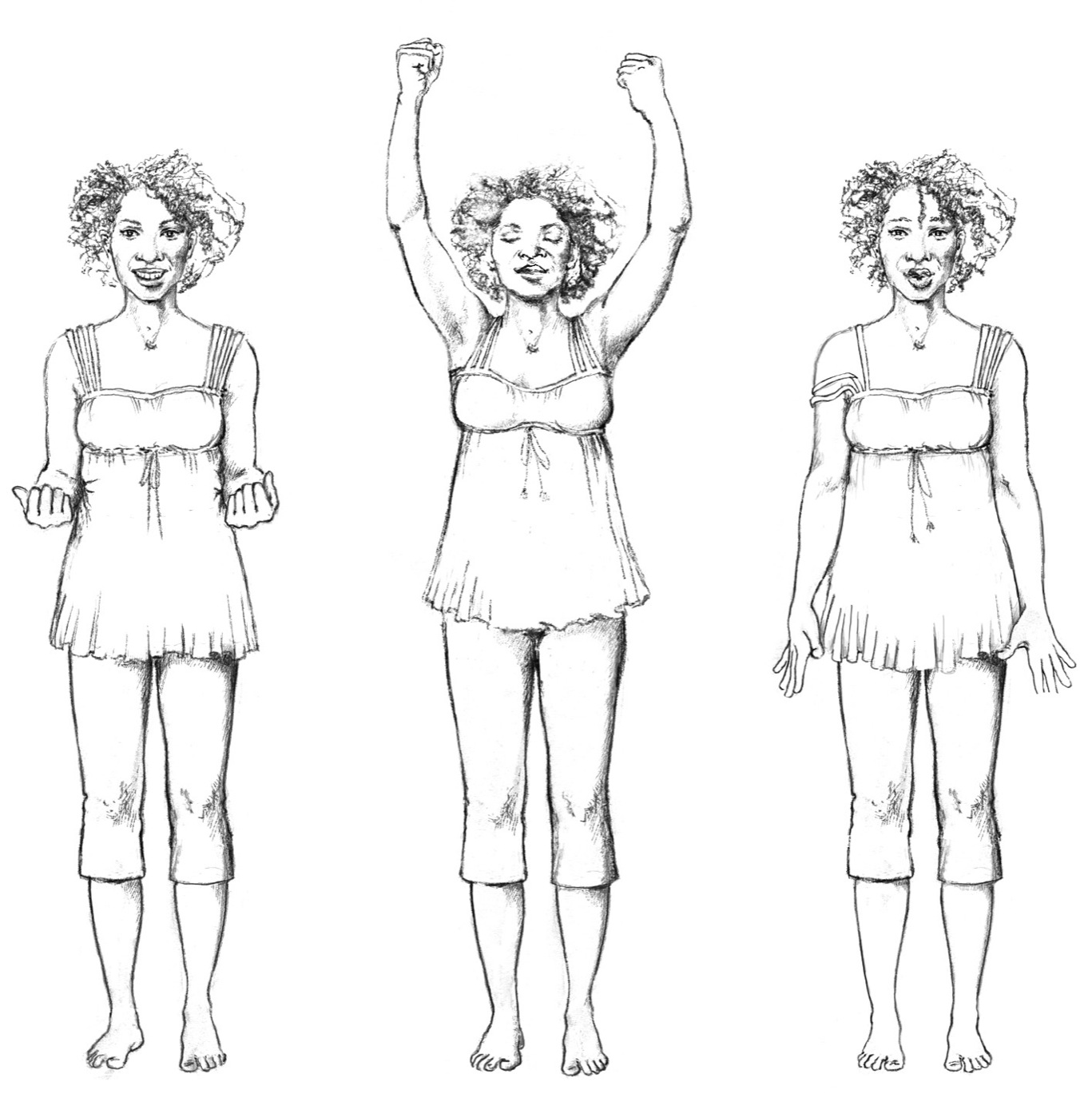
FIGURE 3-2 The Blow-Out
THE ZIP-UP
Zip up by placing either or both hands at your pubic bone and taking a deep in-breath as you move your hand with deliberation straight up the center of your body, to your lower lip (see Figure 3-3). Repeat two or three times. Breathe deeply each time. Your hands emanate an electromagnetic field and, with this movement, you are tracing your Central Meridian, one of the body’s major energy pathways. This strengthens the meridian and tends to stabilize your energies, centering and empowering you.

FIGURE 3-3 The Zip-Up
THE HOOK-UP
Hook in this calm and clarity by placing the middle finger of one hand on your third eye (between your eyebrows above the bridge of your nose) and the middle finger of your other hand in your navel. Gently press both fingers inward, pull them upward, and hold there for at least three deep, full breaths (see Figure 3-4).
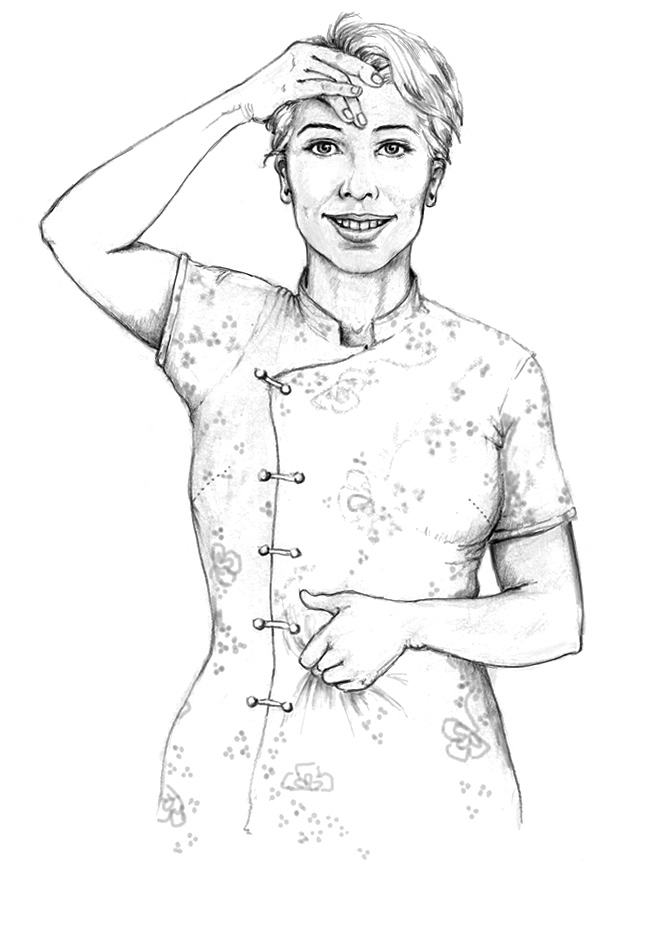
FIGURE 3-4 The Hook-Up
The Crossover Shoulder Pull
Several meridians run through the shoulders and tend to become clogged at the shoulders when we feel stress. This also interferes with natural left-right crossover patterns. All this can be quickly reversed with the Crossover Shoulder Pull.
Place either hand on its opposite shoulder and press in hard behind the shoulder with your fingers (see Figure 3-5). Drag your hand over your shoulder, maintaining the pressure. Continue, with less pressure now, to your opposite hip. Repeat two or three times. Shift to the other side.
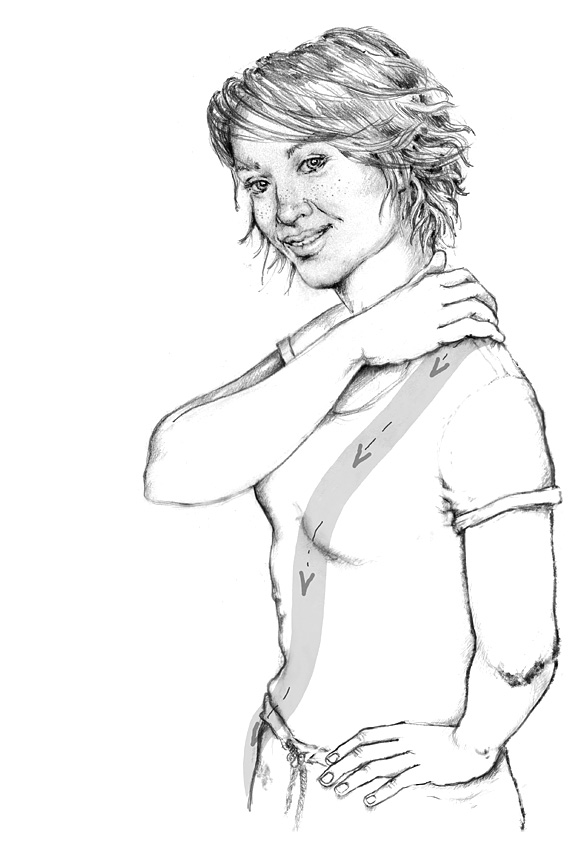
FIGURE 3-5 The Crossover Shoulder Pull
The Crown Pull
While doing the Crown Pull, breathe deeply, in through your nose and out through your mouth.
- Place your thumbs at your temples on the sides of your head. Curl your fingers and rest your fingertips just above the center of your eyebrows (see Figure 3-6).
- Slowly, and with some pressure, pull your fingers apart so that you stretch the skin just above your eyebrows.
- Rest your fingertips at the center of your forehead and repeat the stretch.
- Rest your fingertips at your hairline and repeat the stretch.
- Continue this pattern, fingers curled and pushing in at each of these locations:
a. Fingers at the top of your head, with your little fingers at your hairline. Push down with some pressure and pull your hands away from one another, as if pulling your head apart.
b. Fingers at the center of your head, again pushing down and pulling your hands away from one another.
c. Fingers over the curve at the back of your head, again using the same stretch.
d. Continue down your neck, fingers at the center of your neck, pushing in and then pulling around to the side, finally hanging your fingers on your shoulders.
When you are ready to release, push your fingers into your shoulders, drag them across the tops of your shoulders, and finally drop your hands.
The Stress Release Hold
While we have placed this as the fifth technique in this series, it is a gem that you can use any time you feel emotional distress.
Place the palm of one hand lightly over your forehead and the palm of the other around the back of your head (see Figure 3-7). If you hold them there while breathing deeply for one to three minutes, the energies from your hands and the contact with areas of the skin called “neurovascular points” have the effect of shifting the neurochemistry of stress, turning off the fight/flight/freeze response. First doing the Crown Pull makes your body more receptive for this posture, which you can do sitting, standing, or lying down.

FIGURE 3-7 The Stress Release Hold
The Wayne Cook Posture
This is one of the most powerful techniques we know for restoring clarity of mind. Originally developed by Wayne Cook for working with people who stutter, it has been effectively applied now with a wide range of issues, from helping people with learning disabilities to improving the performance of athletes. The technique involves three postures:
- While sitting, place your right foot over your left knee, wrap your left hand around your right ankle, and wrap your right hand around the ball of your right foot (best done with shoes removed). Your wrists will be crossing over one another (see Figure 3-8a). Breathe in slowly through your nose, lifting your body as you breathe in. At the same time, pull your leg inward, creating a stretch. Exhale slowly out your mouth, letting your body relax. Repeat this slow breathing and stretching four or five times.
- Switch to your other foot. Place your left foot over your right knee, wrap your right hand around your left ankle, and wrap your left hand around the ball of your left foot (see Figure 3-8b). Lift your body and breathe as described above.
- Uncross your legs, place your fingertips together to form a pyramid, and bring your thumbs to rest on your third eye, just above the bridge of your nose (see Figure 3-8c). Breathe slowly in through your nose and out through your mouth about five times.
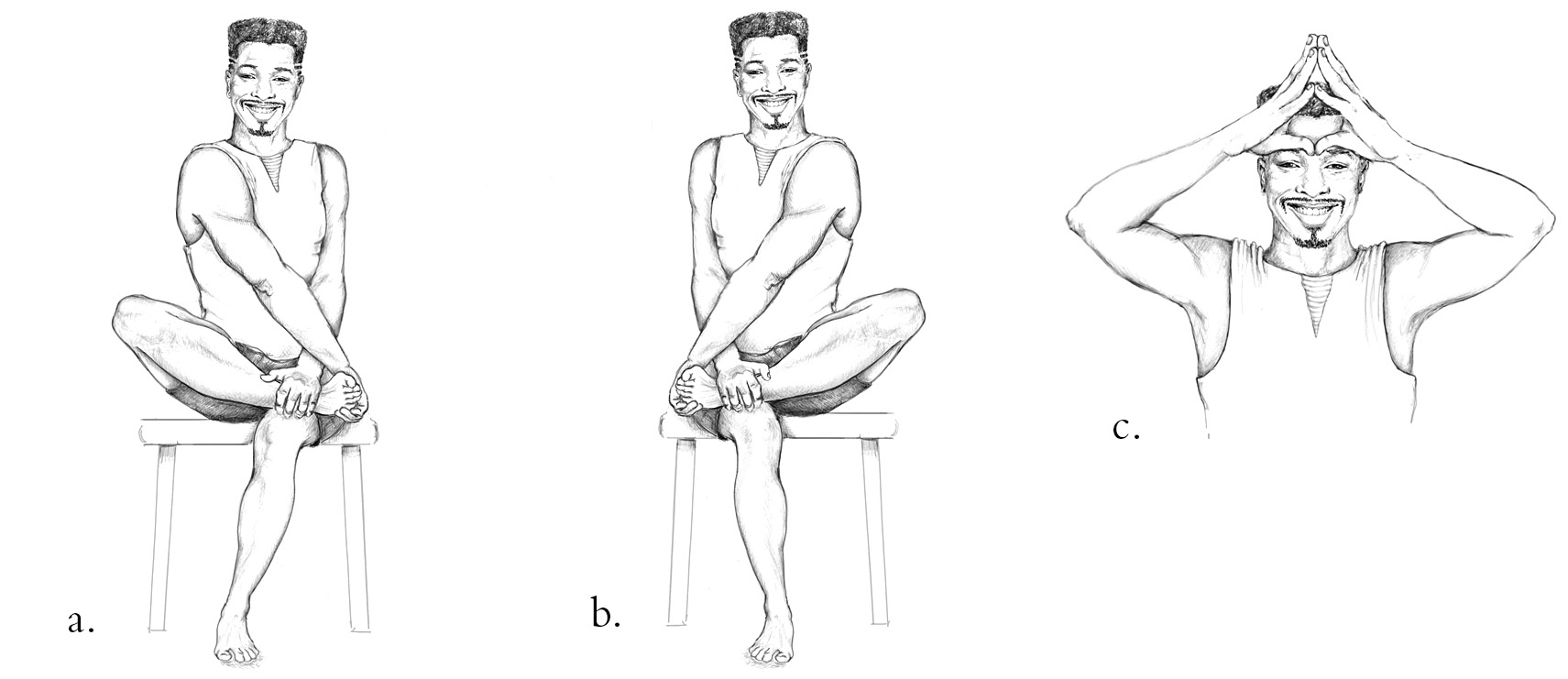
FIGURE 3-8 The Wayne Cook Posture
Connecting Heaven and Earth
Stretching is one of the most natural ways to keep the body’s energies moving, which is in turn one of the best ways to keep your mind clear. From watching cats and dogs upon waking to practicing disciplines that have made stretching into an art form, such as yoga and tai chi, many models are available. Versions of the following exercise have been found in numerous cultures, and it is not only an excellent way to get energy flowing throughout the body, it is formulated to help integrate the brain’s left and right hemispheres and to activate the radiant circuits, the energy system that supports joy.5 To “Connect Heaven and Earth” (see Figure 3-9):
- In a standing position, rub your hands together and then shake them out. Place them on your thighs, with your fingers spread. Then with a deep inhalation, circle your arms out, and on the exhalation bring your hands together into a prayerful position.
- With a deep inhalation, stretch one arm high above your head and flatten the hand palm up (as if pushing something above you); stretch the other arm down and flatten the hand palm down (as if pushing something toward the earth). Stay in this position for as long as is comfortable, then release your breath through your mouth, returning your hands to the prayerful position.
- Repeat, switching the arm that raises and the arm that lowers. Do one or more additional lifts on each side.
- Coming out of this pose the final time, bring your arms down and allow your body to fold over at the waist. Hang there with your knees slightly bent as you take two deep breaths.
- Slowly return to a standing position, ending with a backward roll of the shoulders.
The Cross Crawl
We are designed to replenish our energies through activity. Energy crosses over from the left hemisphere of the brain to the right side of the body and from the right hemisphere to the left side of the body. Figure-eight crossover patterns operate throughout your body, from the biofield that surrounds you down to the double helix in your DNA. When you are stressed, this energy may go into a homolateral, up-down pattern instead of the crossover rhythm that supports your health and vitality. Any activity that involves a crossover motion (e.g., left arm moves at the same time as the right leg, right arm moves with left leg)—such as walking, running, or swimming—tends to boost and balance your energies. One of David’s favorite mood-changers is a vigorous swim. The simplest technique to obtain these benefits, called the Cross Crawl, is in essence simply walking in place (see Figure 3-10).
- While standing or sitting, lift your right arm and left leg simultaneously.
- As you let them down, raise your left arm and right leg.
- Repeat, this time exaggerating the lift of your leg and swing of your arm across your midline to the opposite side of your body.
- Continue this exaggerated march for at least a minute, breathing deeply in through your nose and out through your mouth.
These exercises are not only valuable for re-centering after an argument; they boost your physical health and mental well-being and bring you home to yourself. We encourage you to do them with your partner when you are not under stress so you familiarize yourself with them and get a glimpse of their general benefits. You will also get a sense of which techniques are likely to provide the best first aid for you.
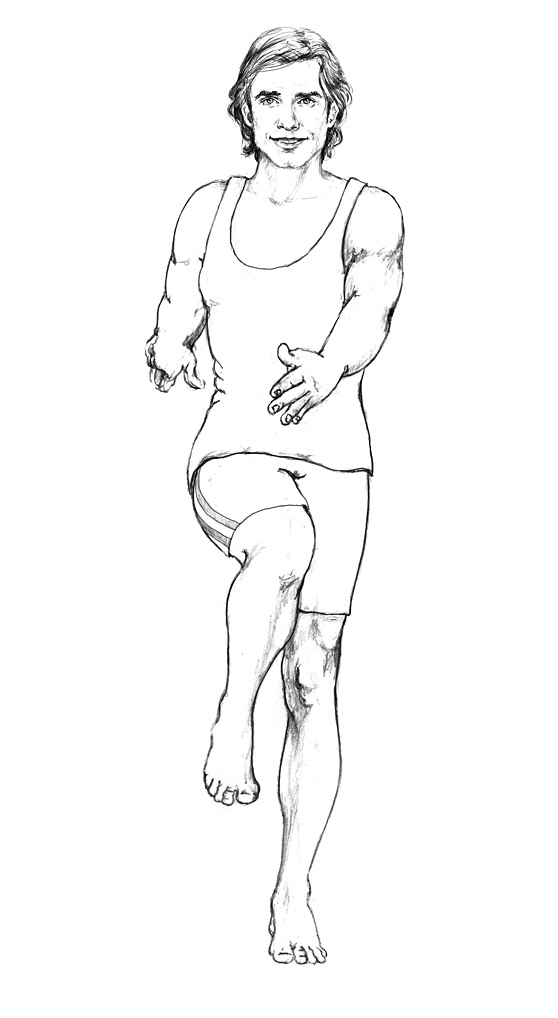
FIGURE 3-10 The Cross Crawl
Part 3 of the STAR Pact: Attune
By this point in the Pact, you have realigned your own energies. Your partner has done the same. This third part of the Pact will help you reconnect. Your bond has been strained or perhaps even feels ruptured. So you now face not only the task of resolving the disagreement but also of repairing the bond. You can start to repair the bond by realigning your energies with your partner’s.
Attuning Energetically
Doing a few of the centering exercises described above in unison with your partner, such as the Four Taps or Connecting Heaven and Earth, gives your energies a chance to realign naturally. No discussion is necessary. Or take a brisk walk, the classic Cross Crawl activity, with an agreement that you will comment only on what you observe during the walk rather than reenter the discussion just yet. Attend particularly to objects of beauty or interest. While it takes some discipline to stay focused on the here and now of the walk rather than to reengage the argument, you begin to bridge with one another energetically as you together exercise your powers of observation and description during a joint Cross Crawl activity. Our all-time favorite energy medicine technique for wordlessly reattuning is to give one another a Spinal Flush.
THE SPINAL FLUSH
The Spinal Flush is a brief massage along the spine, a kind act you can do for your partner even before you are feeling kind or able to say kind things. It is a gift you can give to one another as an act of good faith. First, it is easy to give and feels great to receive. Second, it releases toxins that are generated by the fight/flight/freeze response back into the lymph system, where they can be eliminated. Third, it brings balance to each of the major meridians, the body’s energy pathways. Deep, caring touch is good for your partner’s health and mood, as well as your own. In fact, University of Miami psychologist Tiffany Field reports that receiving fifteen minutes of massage each day from their husbands was as beneficial for women suffering from postpartum depression as receiving antidepressant medication.6 By focusing on your back instead of the more emotionally vulnerable front of your body, you are more able to receive a caring gesture even while still closed off or feeling defensive. To do the Spinal Flush:
- Have your partner lie facedown or stand three to four feet from a wall and lean into it with both hands. Either position stabilizes your partner’s body so pressure can be applied along the spine. When David sees Donna starting to flood, his code phrase for initiating a Spinal Flush is “Up against the wall, Donna.”
- Massage the points down both sides of your partner’s spine (but not directly on the spine), using the thumbs or middle fingers and using your body weight so strong pressure is being applied. While most people can tolerate and will enjoy considerable pressure on these points, check to be sure you are not using more than your partner wishes. If your partner has any kind of back injury or vulnerability, be particularly diligent about checking in, though deep pressure along the sides of the spine will still usually be safe and beneficial. You will be massaging from the bottom of the neck all the way down to the bottom of the sacrum.
- Go down the notches along the vertebrae and deeply massage each point. Staying on each point for at least five seconds, move the skin to and fro or in a circular motion with strong pressure.
- You can stop when you reach the sacrum or repeat the downward flush once or twice more.
- When completed, “sweep” the energies down your partner’s body: With either one long swipe or several brushstrokes, use the palms of your hands to sweep the energy from the shoulders all the way down the legs and off the feet. Repeat the sweep two or three times.
The Spinal Flush
The toxic energy of distress gets clogged along the spine, interfering with the function of major nerves and energy pathways. As the fingers press on these points, the clogged energy becomes dispersed into the lymphatic system, which empties it out of the body.
Giving the Spinal Flush When You Are Angry
Interestingly, if the partner giving the Spinal Flush is angry, as may occur after an argument, the anger does not get absorbed by the person receiving the Spinal Flush. While angry energy certainly can be transmitted through touch, the anger gets dissipated rather than transferred during a Spinal Flush.
THE DESIRED STATE
When you are arguing with your partner, “flooding” is a physiological state in which you are feeling overwhelmed by your own and your partner’s negative emotions while you focus on an issue.7 Any relationship has many such moments. During flooding, people are likely to become defensive, pursue conflict, and at the same time wish to get away. This is not the desired state, but each time it occurs provides an opportunity for emotional reconnection. Stations on the path to reconnection include self-soothing, soothing one another, and attuning to one another’s feelings. The underlying tone of your relationship becomes a bit more positive with each successful reconnection, and a bit more negative each time a flooding incident does not lead to reconnection. At this point, your Pact has given you tools from energy medicine for self-soothing and for connecting energetically with your partner. If you or your partner are still feeling flooded, go back to the exercises. If you are both feeling calm, though perhaps still pessimistic about resolving the issue, you can proceed.
Attuning Emotionally
Stopping when you are flooded, centering yourself, and energetically reattuning with your partner is like pressing the reset button on your interaction. What you do next is critical. If you just pick up where you left off, you are likely to find that one of you, and then both of you, may soon be feeling flooded again. But in centering and reconnecting energetically, you have primed yourself for a shift.
Attuned and Broken Bonds
When the bond is there between two people and they are feeling attuned, the energy literally forms figure-eight patterns that loop back and forth between them. This energy connects them at their Heart Chakras, at their Sixth Chakras (at the third eye, between the eyebrows), and often at other chakras as well. When the bond is broken, the disrupted energy is palpable.
SHIFTING YOUR FOCUS
Rather than focusing on your side of the disagreement, or all the reasons you are right and your partner is wrong, or all the ways you have been unfairly perceived or dismissed, this is a moment where the most constructive choice available to you is to attune to your partner’s feelings. It is not that you discount or disregard your own reality, but rather that you establish an ability to hold both perspectives at once. You don’t need to make yourself wrong to attune to your partner, but attunement shifts your attention. It puts you on a path that veers away from flooding or blaming and toward repairing the bond.
At times, our Energetic Stress Style tends to seize control, distorting our perceptions as reliably as the blind man who is able to perceive only one part of the elephant. While all couples fight and a relationship can weather many arguments that go unresolved, Gottman’s research shows that a couple is headed for divorce when criticism, defensiveness, contempt, and stonewalling escalate over time.8 Consistently responding to sadness or anger with criticism, dismissal, or contempt intensifies negativity and becomes cumulative. Attunement, on the other hand, enhances intimacy. Rather than abandoning your truth for your partner’s, attunement means opening to your partner’s experience, even vividly imagining how it feels to be him or her, and proceeding with compassionate awareness of your own as well as your partner’s position.
Your Pact has had you (1) force an interruption in an escalating argument, (2) center yourself using energy techniques, and (3) do a Spinal Flush or other energy exercise that is soothing for your partner and begins to energetically reestablish your connection. In the next crucial step, you will proceed into a deeper, heartfelt awareness of your partner’s emotional state.
PUTTING YOUR PARTNER’S THOUGHTS AND FEELINGS INTO WORDS
Place your hands over your Heart Chakra (the middle of your chest). Breathing deeply, center your awareness in your heart. Visualize your partner as a child: young, fresh, innocent, undamaged. Absorb this for a few moments. Next bring your attention back to the argument. Breathing deeply and “seeing” through your heart, see that pure version of your partner, even during the argument. Attuned to your partner in this way, mindfully step into his or her shoes. Experience the argument as if you were your partner.
Inevitably your own opinions, anger, or hurt will intrude into the scene. Do not try to stop them or judge them. Instead, bring your focus to your hands over the center of your chest and observe your own feelings from this heart-centered space. Thoughts and feelings may pass or simply dissolve as you meet them with curiosity and acceptance. If they do not dissipate, or if they intensify, rather than dwelling on them further, use the Blow-Out/Zip-Up/Hook-Up exercise (here) to dispel their energies.
When the feelings have passed, return to the image of your partner and to imagining the argument through your partner’s eyes and heart. Sense your partner’s likely feelings, thoughts, and hopes during the interaction. Write your insights in a paragraph or two in first-person present tense, describing the experience as if you are your partner. You will be able to verify the accuracy of your account in the final part of the Pact.
Part 4 of the STAR Pact: Resolve
It is now time to return to the original issue and resolve it. Teaching active listening, much to the dismay of many conventionally trained couples therapists, has been found to be relatively ineffective in improving marital satisfaction or stability.9 While active listening is great in theory, it is difficult to be constructive listeners when the hostility, anger, and defensiveness of flooding have been evoked. On the other hand, shifting to an activity that changes your energies can be done in a mechanical manner and still be effective.
You are about to enter Part 4 of your Pact, the phase of effective communication—reengaging and resolving the issue that propelled you into flooding, disconnection, and discouragement. You have already centered yourself, reconnected energetically, inwardly attuned yourself to your partner’s feelings and position, and written your insights. Now you are at the phase where the rubber meets the road. Decide who will read first. Before you begin, simultaneously and in unison do one more brief centering technique. David’s favorite is the Crossover Shoulder Pull. Donna is most likely to use the Wayne Cook Posture. If your preferences are also different from one another’s, use both. A favorite for both of us is simple hands-over-heart breathing.
Sharing Your Empathic Statement
Read the piece you wrote at the end of Part 3 of the Pact. Your partner listens and receives your attempt to tune into his or her experience. Your Pact is still providing the structure of an invisible surrogate “couples coach.”
Responding with Appreciation
Once you have read your account of your partner’s side of the story, your partner is to respond with three sentences that begin with the words “I appreciate . . .” Knowing this assignment is coming up will help your partner scan for your genuine effort, accurate insights, and enhanced empathy. The appreciations can be simple and basic: “I appreciate that you know how hard I tried.” “I appreciate that you are wanting to understand me.” “I appreciate that you understand that I didn’t mean to overreact.”
This does not mean your partner is saying that every statement you uttered was on target; only that your partner acknowledges and appreciates your efforts. You will also be receiving feedback about how accurate your statements were according to your partner’s experience. Sometimes the statement being read will totally miss the mark. Appreciations can still focus on the partner’s intentions in writing and sharing the piece. After each appreciation statement, respond with an active acknowledgment: a “thank you,” a smile, or a request, such as “Help me understand that better.”
Further Inquiry
Next you ask, “Is there anything else you would like me to understand about your experience regarding our disagreement?” If your partner feels fully understood, this round is completed and it is your turn to hear your partner’s statement. More likely, however, your partner will have at least one area to expand on or correct. Your partner selects only one at this point, so the response is one or two sentences describing or clarifying one aspect of the situation, such as: “I wasn’t angry that you were busy; I was angry that when I asked you to help me, you looked disgusted.” Or, “My feelings got hurt at the party when you were bragging about our garden and didn’t mention how much work I put into it.” Or, “I felt discounted when you still punished Susie [their seven-year-old daughter] after I’d explained why I thought we should let her off the hook this time.” The statements should be brief and descriptive of what happened rather than any interpretation of the meaning of the events except to state how they impacted the speaker. Use “I statements” about your feelings, thoughts, and reactions.
Bringing in the “Do You Mean” Technique
Your partner has just expanded on or corrected your write-up. This may be a perfect time to use the “Do you mean” technique (here). Drawing from the earlier example, suppose your partner’s comment was:
“I felt discounted when you still punished Susie after I’d explained why I thought we should let her off the hook this time. You always discount me!”
Looking for where to focus, “You always discount me!” provides much that is worth exploring. So you might put this into the “Do you mean” format. For instance:
“Do you mean that I ignored what you were saying?”
“Yes.”
“Do you mean by saying I always discount you, that I never take in what you are saying?”
“No.”
“Do you mean by saying always that you feel discounted a lot of the time?”
“Do you mean that you don’t trust me?”
“There may be some truth in that, but that is not what I am saying.”
“Do you mean that I run my agenda while ignoring yours and that it is because I’m insensitive and selfish?”
“The first half of that is what I mean, so you now have two and a half yeses.”
“Do you mean you want to leave me?”
“No.”
“Do you mean that you want me to be influenced more by what you say?”
“Bingo!”
Even the four-word sentence “You always discount me” can have multiple meanings. It could easily be misinterpreted. After achieving three yeses, summarize what was just established to the extent that you can acknowledge your partner’s initial meaning or feeling and check for accuracy:
“So you felt I ignored what you said—it reminded you of other times you have felt ignored—and you stated this so strongly because you don’t want that to keep happening. Given that, I can understand why you were feeling discounted. Did I getcha?”
If the response was, “Not completely. I thought we should have let Susie off the hook this time,” your “Do you mean” questions could try to capture your partner’s meaning about the entire statement or any aspect of it. For instance:
“Do you mean I should always just obey you?”
“No.”
“Do you mean Susie is such an angel that we should never punish her?”
“No.”
“Do you mean you felt I was too harsh?”
“Yes.”
“Do you mean Susie didn’t deserve to be punished this time?”
“Yes.”
“Do you mean that you are smarter than me?”
“While I do believe that is true, it’s not what I am saying.”
“Do you mean that you are oversensitive about not being taken seriously?”
“NO!”
“Do you mean that you were hurt that I didn’t give your opinion more weight?”
“Yes.”
“I can understand how my punishing Susie after you explained why you felt we should let this one go would leave you feeling discounted. Now do you feel fully understood?”
“Yes. Thank you for making the effort!”
Missing a “Do You Mean”
What happens energetically when your partner’s “Do you mean” statement is dead wrong? It was not what you meant at all. Does this cause the energies between the two of you to repel further? It usually doesn’t. In fact, the bond that had been broken tends to repair whether the partner’s response is right or wrong. The energy reconnects. The fact that the partner was curious and trying to understand energetically trumps the fact that the guess was wrong.
Accepting the Outcome
Often the discordant feelings will have dissolved or the disagreement will have been settled before you even get to the first “Do you mean” in Part 4 of the Pact. But sometimes the outcome is simply, “We agree to disagree.” In fact, one of John Gottman’s most unexpected findings was that, more than two-thirds of the time, couple conflict was about “perpetual issues in the relationship that never got resolved.”10 If you come to fundamental differences in your characters, values, or beliefs that you cannot settle, you may wonder what you are doing on the same train. All couples, however, have issues they have been unable to resolve.
Many couples “make peace” with such perpetual problems by going into denial about them. But if deep problems become permanently buried in the foundation of your relationship, your footing with one another becomes unsure. Or, in the other direction, unremitting complaints and nagging build barriers and ill will without doing anything to constructively resolve the issue. The solution that happy couples reached around their irreconcilable differences “was to establish a ‘dialogue’ around the perpetual problem—one that included humor and affection and communicated acceptance of the partner and even amusement. In this way happy couples coped with the irresolvable problems rather than to get trapped in ‘gridlock.’”11 Your pact helps you accomplish this.
Whether guiding you through the inevitable bumps of building a life together or helping you establish a constructive dialogue around irresolvable issues, your Pact calls to the best in each of you. If the issue is resolved, you can happily celebrate your accomplishment. If, on the other hand, a problem persists after you have submitted it to the rigors of your Pact, you can recognize that you have come into territory all couples encounter. You will know you have done all you can, at least for the time being. In Part 2, you will learn an approach from energy psychology for getting at the heart of and transforming some “perpetual” problems, but for now, you will have brought your goodwill, caring, and most effective communication skills for coming to terms with a stubborn difference in a loving and mutually supportive way.
Making the Pact a Reality
If nothing else, shifting a disagreement from automated but unproductive knee-jerk reactions to the relatively laborious steps in the Pact is an affirmation to yourself and your partner that your relationship and its well-being are at the top of your priorities.
Perhaps the hardest times for us to invoke the Pact were in premenstrual moments when, at least as David experienced it, there was no right response. Whatever he would do or say seemed to make matters worse. Every cell in his digital brain wanted to pull away, separate, take time apart. This is similar to the “Stop” phase of the Pact, but it isn’t quite on the mark because when done abruptly or with anger, it breaks emotional contact in a manner that feels like punishment or abandonment. It doesn’t feel like an affirmation of the agreed-upon steps in the Pact. David learned, however, that he could bridge his impulse to withdraw into a constructive scenario by saying something like: “Donna, we’re both upset right now and having a hard time. Let’s follow our Pact, take a few minutes apart, get ourselves centered, and then how about I give you a Spinal Flush.” That extra step was the kingpin to success. Sometimes all was well following the spinal flush. Other times, the remainder of the Pact was still needed.
A Commitment
Giving your Pact the power of a contract is not an idle choice. Before you commit to the Pact, try it. Experience the structured steps of Stop, Tap, Attune, and Resolve (STAR). Then evaluate. How well did this work for you? Did the experience give you hope? What did you learn for next time? Does it feel promising enough that you want to commit to making the Pact a part of your relationship? If you decide to do so, be prepared to deeply honor your commitment. When you make a promise to one another, particularly when it concerns the well-being of your relationship, keeping that promise affirms your partnership; breaking it erodes trust.
When you are acting in accordance with the Pact, you are diverted from the downward spiral of relationship conflict and are instead establishing new patterns. With your first success in using the Pact to transform a conflict into enhanced intimacy and understanding, you have created a prototype, a model of successful attunement during a challenging time. The principles of attunement you are developing for difficult moments will echo throughout your relationship, but you don’t have to wait until you are devastated or furious to use them. The more you use them, the less frequently or urgently you will have to invoke your Pact.
It is not whether you argue or are triggered into flooding with one another that determines stability and satisfaction in a marriage, but how you repair the ruptures to your connection when they do occur. The resolution of each incident involving a breach in your bond has a cumulative impact on your sense of safety and on the way you view one another. It can increase your appreciation and add to your shared trust and bonding—or it can add to a backlog of hurt, negativity, and discouragement, and an escalating focus on what seems wrong with your partner and the relationship while minimizing what is right. Each time you invoke your Pact, you are affirming your intention, right then and there, to resolve this challenge in a manner that restores your connection and enhances your mutual understanding and affection.
A Weekly Meeting for Appreciation and Taking Stock
We have one more clause to add to your Pact. Relationships, like any other living entity, require care and feeding. Rather than waiting for encounters that lead to flooding to use the Pact, make it part of your Pact that you set aside an hour per week of protected, sacred time to reflect on (1) how you have enjoyed one another during the week, (2) how you have supported one another, and (3) any problems or resentments that may be brewing. Consider it a date with your surrogate “couples coach.” Have your Pact ready in case you need it to work your way through problems that are identified. Doing this kind of preventive maintenance with your Pact at your side will, paradoxically, mean that you need to invoke your Pact less frequently.
In a Nutshell
While you may need to review the detailed instructions provided in this chapter a number of times before the Pact is internalized, here they are in outline form. As you use the Pact, you will no doubt see ways to adapt it to make it more appropriate to your own personal styles, but internalizing this basic structure is a powerful starting point. The Pact, stated as an agreement, is as follows:
- Stop! When either of us is becoming upset or flooding during an interaction, we will interrupt the conversation and invoke the Pact.
- Tap. We will each immediately do the Four Taps and draw on other energy medicine centering techniques presented in this chapter, or others we know to be effective, and use them. We will agree on a time that we will come back together for the next step.
- Attune. Following these exercises, we will energetically attune with one another through a shared activity such as a “here and now” walk, a Spinal Flush, or other energy technique. We will then, from a heart-centered space, review the interaction that just occurred with a strong intention of understanding the other’s emotions, experience, and position. This does not mean that we agree, but that we will step into the other’s shoes with an attitude of curiosity and respect. We will each write this understanding in our partner’s voice.
- Resolve. We will share our written passages about each other’s experience with a firm intention for heart-centered communication, taking opportunities to articulate genuine appreciations along the way. We will continue the dialogue—using the “Do you mean” technique if necessary—until we reach agreement or respectfully agree to disagree.
Final Piece of the STAR Pact
We will dedicate at least an hour each week to creating protected, sacred time for appreciatively reflecting on our lives together that week.
On to Chapter 4
Your desire to maintain intimacy and a collaborative alliance with your partner is in itself a beautiful intention. It can be powerfully supported by understanding your own and your partner’s Energetic Stress Styles (chapter 1), effective strategies for working with your own style and your partner’s style (chapter 2), and the Pact (this chapter). Next, we shift our focus to the brain chemistry of love, the stages of love, and the yin and yang energies that shape a relationship.
